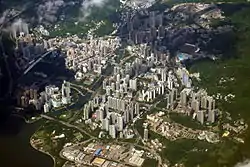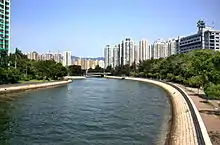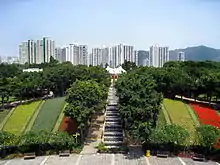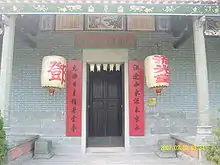Tai Po
Tai Po /ˌtaɪˈpoʊ/ is an area in the New Territories of Hong Kong. It refers to the vicinity of the traditional market towns in the area presently known as Tai Po Old Market or Tai Po Kau Hui (大埔舊墟) (the original "Tai Po Market") on the north of Lam Tsuen River and the Tai Po Hui (the current Tai Po Market; historically Tai Wo Shi, literally Tai Wo market) on Fu Shin Street on the south of the Lam Tsuen River, near the old Tai Po Market railway station of the Kowloon-Canton Railway (British Section). Both market towns became part of the Tai Po New Town in the late 1970s and early 1980s. In present-day usage, "Tai Po" may refer to the area around the original market towns, the Tai Po New Town (Chinese: 大埔市), or the entire Tai Po District.
| Tai Po | |||||||||||||
|---|---|---|---|---|---|---|---|---|---|---|---|---|---|
 Aerial view of Tai Po New Town, including Tai Po Market | |||||||||||||
| Traditional Chinese | 大埔 | ||||||||||||
| Simplified Chinese | 大埔 | ||||||||||||
| |||||||||||||




Etymology
In Chinese, the place, Tai Po (大埔), was formerly written as 大步. Treating the Chinese characters separately, the pronounce of Po in the third tone (Chinese: 埔; Jyutping: bou3; Cantonese Yale: bou; lit. 'port') in Cantonese are shared with many words, not only Po in the sixth tone (Chinese: 步; Jyutping: bou6; Cantonese Yale: bouh; lit. 'Step'). For example the "Po" (埗) of Sham Shui Po, literally deep water port. Moreover, according to the Kangxi Dictionary, the word 埠; 'port' can be written as 步. As a coincidence, Tai Po is a seashore town. The name Tai Po Hoi (Chinese: 大步海; lit. 'Tai Po sea') was appeared in Nanhai Zhi (南海志) of the Yuan dynasty (1271 to 1368 of Gregorian calendar), which stated that pearl was the product of the Tai Po sea.[1] In Ming dynasty's Yue Daji (Chinese: 粵大記; Jyutping: jyut6 daai6 gei3; Cantonese Yale: yuht daaih gei), recorded the names Tai Po Hoi and Tai Po Tau (大步頭).[2][3] In the attached map of that book, the sea next to Tai Po Tau was labelled with "can shelter hurricane" (Chinese: 可泊颶風).[2] In early Qing dynasty Kangxi 27th Year edition of Xin'an Xianzhi (literally Gazetteer of the Xin'an County), Tai Po Tau Hui (lit. 'Tai Po Tau market') as market centre (墟市), Tai Po Tau as village (under the administration of 六都) and Tai Po Hoi as water body, were recorded.[4] According to Hong Kong sinologist and historian Jao Tsung-I, the character Po in Tai Po, should interpreted as port or sea side.[5]
However, there was another urban legend version of the meaning of Tai Po. In the urban legend, the area around Tai Po was a habitat of wild animal, which people have to "Big-Step".[6]
History
Tai Po as a populated place, could be traced back to the Stone Age. Archaeological site in Yuen Chau Tsai, had discovered stone axe and pottery which was believed to be made in Neolithic era.[7] The indigenous inhabitants of Tai Po lived by clamming and pearl farming in Tai Po Hoi (literally Tai Po Sea; Tolo Harbour) since at least AD 963.[7] The pearl making business reached its peak during the Song Dynasty and started to decline gradually in the midst of the Ming Dynasty. Tai Po had been developed as a fishing port around the late Ming Dynasty and the Qing Dynasty. While a village that belong to the modern day Tai Po area, Wun Yiu (Chinese: 碗窰), had developed into a center of porcelain industry in the Ming dynasty.[8]
Tang clan migrated from the area north of the border of the modern day Hong Kong to the modern day the New Territories of Hong Kong in the Song dynasty of China. A branch of Tang clan was split from Lung Yeuk Tau of the modern day the New Territories, to establish the village in Tai Po Tau. The Tai Po Tau branch and Lung Yeuk Tau branch also founded the first Tai Po Hui the market town (also known as Tai Po Tau Hui), despite it is now defunct and the area now known as Tai Po Old Market. The area around the first market town, also lived other people that were not from the Tang clan. They formed an inter-villages alliance Tai Po Tsat Yeuk (literally Tai Po Seven Alliances; each alliance contained one or more villages). The inter-villages alliance founded another market town Tai Wo Shi (literally Tai Wo market) after the Qing government ruled that Tai Po Hui (Tai Po Tau Hui) was belonged to Tangs, other clans cannot open shops in Tang's market town. However, Tai Wo Shi replaced the original Tai Po Hui (Tai Po Tau Hui) as the main market, and took the name Tai Po Hui (anglicized as Tai Po Market). The old market town thus became Tai Po Kau Hui (anglicized as Tai Po Old Market; Jyutping: daai6 bou3 gau6 heoi1).
During the British colonial rule, a District Office, a police station, two railway stations: Tai Po Market railway station and Tai Po Kau railway station (in Tai Po Kau; Jyutping: daai6 bou3 gaau3) and other public facilities were built with-in the modern day area that belong to the new town and the administrative district. Most of them in close distance with the market town of Tai Po at that time.
In the 1970s, the Hong Kong government began to develop satellite towns: Tai Po Industrial Estate, the first industrial estate in Hong Kong was built in the reclaimed land of the former Tai Po Hoi in 1974; Tai Po was named as a site to built "new town" in 1979, which the government obtain lands by reclamation of the river mouth and Tai Po Hoi. The new town was also designed to incorporate and interact with the existing market town. The first public housing estate of Tai Po New Town: Tai Yuen Estate – was established in 1981. The population has soared to 320,000, and Tai Po New Town began to prosper following the completion of the Tolo Highway which were integrated with the older urban areas.
At present, due to the development of the new town, the place name Tai Po may refer to Tai Po New Town or the historical area centre Tai Po Market, or the Tai Po District (excluding exclave Sai Kung North) that cover the new town and Lam Tsuen Valley and other area. However, the boundary of Tai Po was not defined. In contrast, a namesake election constituency of Tai Po Market had its legally defined boundary, as well as Tai Po District; Tai Po New Town also had its officially defined boundary in urban planning regulation and law. Moreover, Hong Kong police, as well as primary and secondary schools district, had their own boundaries.
Education

In historical eras clan villages organised private study halls or sishu (Chinese: 私塾; pinyin: Sīshú; Jyutping: si1 suk6; Cantonese Yale: sī suhk). King Law Ka Shuk, is a declared monument of Hong Kong. It is the ancestral hall of Tang clan Tai Po Tau branch, and historically a study hall.[9] Village schools opened with government subsidies in the early 20th century.[10] In the 1920s and 1930s secondary schools in the vernacular medium opened in Tai Po.[11] Many village schools opened after World War II. Due to a decline in the birthrate, by the 1990s the number of school students was declining and many village schools began to close.[10]
In present day, Tai Po is part of the school districts of Tai Po District. Several international school also located in the district.
See also
References
- 陳大震 (1304). 南海志 (in Literary Chinese). Retrieved 3 January 2019 – via archive.org.
- 郭棐 (1595). Yue Daji 粵大記 (in Literary Chinese).
- 王賡武 (3 December 2016). 香港史新編 (revised ed.). p. 49. ISBN 9789620438851.
- 地理志. 新安縣志 (in Literary Chinese) (Kangxi Years ed.). 1688.
- Jao Tsung-I (1983). 港、九前代考古雜錄 (PDF). 新亞學術集刊 [New Asia Academic Bulletin] (in Chinese). 4: 170–171 – via HKU Library digital scan.
- 葉靈鳳「香港史系列」. 館藏精粹 column. 香港文學通訊 (in Chinese). No. 150. Chinese University of Hong Kong Library. 31 January 2016. Retrieved 10 December 2019.
- 蕭國健 (2007). 歷史沿革. 大埔風物志 (PDF) (in Chinese) (revised ed.). Tai Po District Council.
- "Pottery Kilns at Wun Yiu Village, Tai Po - Declared Monuments - Antiquities and Monuments Office". www.amo.gov.hk. Retrieved 5 June 2020.
- "King Law Ka Shuk". Hong Kong: Antiquities and Monuments Office. Retrieved 3 January 2019.
- Poon, Shuk Wah. "Education in Tai Po: From the Founding of Rural Normal School to the Demise of Village Schools" (Archive). Traditions and Heritage in Tai Po. p. 256.
- Hase, Patrick H. (2013). "Introduction: The Traditional New Territories, Land and Society". Custom, Land and Livelihood in Rural South China: The Traditional Land Law of Hong Kong's New Territories, 1750-1950. Royal Asiatic Society Hong Kong Studies Series. Hong Kong University Press. p. 18. ISBN 978-988-8139-08-8.
Further reading
- Cheung, Kwok-hung Stephen (張國雄). "Traditional folksongs in an urban setting: a study of Hakka Shange in Tai Po, Hong Kong" (Archive). University of Hong Kong, 2004. - Information
External links
| Wikimedia Commons has media related to Tai Po. |